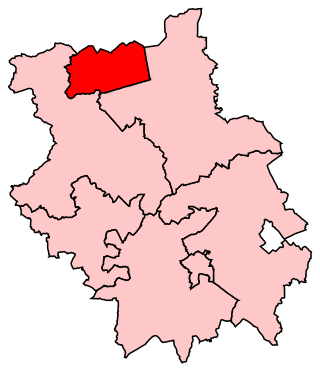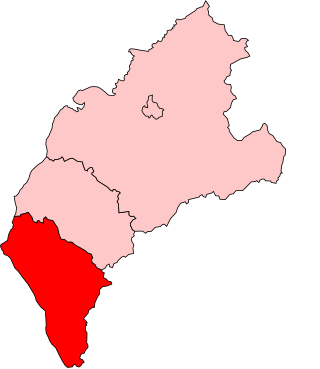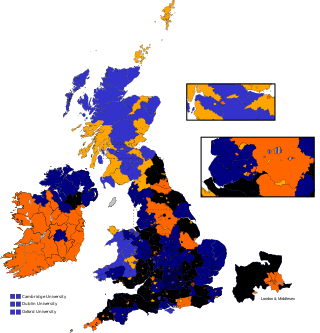
Corby and East Northamptonshire is a constituency in the English county of Northamptonshire. It is represented in the House of Commons of the UK Parliament since May 2015 by Tom Pursglove, a Conservative.

Peterborough is a borough constituency represented in the House of Commons of the Parliament of the United Kingdom since 2019 by Paul Bristow of the Conservative Party.
Edinburgh and St Andrews Universities was a university constituency represented in the House of Commons of the Parliament of the United Kingdom from 1868 until 1918. It was merged with the Glasgow and Aberdeen Universities constituency to form the Combined Scottish Universities constituency.
Sutherland was a Scottish constituency of the House of Commons of the Parliament of Great Britain from 1708 to 1801 and of the Parliament of the United Kingdom from 1801 to 1918.
Linlithgowshire was a Scottish county constituency of the House of Commons of the Parliament of the United Kingdom from 1708 to 1950. It elected one Member of Parliament (MP) by the first past the post voting system. It was replaced in 1950 by an equivalent constituency named West Lothian.
EastAberdeenshire was a Scottish county constituency of the House of Commons of the Parliament of the United Kingdom from 1868 to 1918 and from 1950 to 1983. It elected one Member of Parliament (MP) by the first past the post system of election.
Wick Burghs, sometimes known as Northern Burghs, was a constituency of the House of Commons of the Parliament of the United Kingdom from 1832 to 1918. It elected one Member of Parliament (MP) by the first past the post voting system.

South Northamptonshire is a constituency represented in the House of Commons of the UK Parliament since its 2010 recreation by Andrea Leadsom, a Conservative who served as Secretary of State for Business, Energy and Industrial Strategy until 13 February 2020. She was Leader of the House of Commons from 2017 to 2019, and Secretary of State for Environment, Food and Rural Affairs from 2016 to 2017. The seat of South Northamptonshire is considered a Conservative safe seat, having elected a Conservative MP at every election for 110 Years. Current Conservative MP Andrea Leadsom was re-elected in 2019 with an increased majority. In May 2024, she announced that she would stand down as an MP at the up-coming general election.
Wigtownshire, was a Scottish constituency of the House of Commons of the Parliament of Great Britain from 1708 to 1801 and of the Parliament of the United Kingdom from 1801 to 1918. It was represented by one Member of Parliament.
Stirlingshire was a Scottish county constituency of the House of Commons of the Parliament of Great Britain and later of the Parliament of the United Kingdom from 1708 until 1918. It elected one Member of Parliament (MP) by the first past the post voting system.
Stalybridge officially sometimes written in early years as Staleybridge was a constituency represented in the House of Commons of the UK Parliament from 1868 until 1918 by one MP. It comprised the borough of Stalybridge which lay in Lancashire and Cheshire and which is in the east of today's Greater Manchester. On abolition for the 1918 general election under the Representation of the People Act 1918 the seat's main replacement became Stalybridge and Hyde.
Ashburton was a borough constituency represented in the House of Commons of the Parliament at Westminster, for the Parliaments of 1295 and 1407, and regularly from 1640 until it was abolished for the 1868 general election. It was one of three Devon borough constituencies newly enfranchised in the Long Parliament. It returned two Members of Parliament until the 1832 general election when the number was reduced to one MP.

Petersfield was an English Parliamentary constituency centred on the town of Petersfield in Hampshire. It existed for several hundred years until its abolition for the 1983 general election.

Whitehaven was a constituency centred on the town of Whitehaven in Cumberland, which returned one Member of Parliament (MP) to the House of Commons of the Parliament of the United Kingdom.

East Norfolk was a constituency in the county of Norfolk that returned two members of parliament to the House of Commons of the Parliament of the United Kingdom from 1832 until 1868. It was re-established in 1885 with representation of one member. That seat was abolished in 1950.
Mid Northamptonshire was a county constituency in Northamptonshire, which returned one Member of Parliament (MP) to the House of Commons of the Parliament of the United Kingdom, elected by the first past the post system.

East Somerset was the name of a parliamentary constituency in Somerset, represented in the House of Commons of the Parliament of the United Kingdom between 1832 and 1918.
Wilton was the name of a parliamentary borough in Wiltshire. It was represented in the House of Commons of the Parliament of England from 1295 to 1707, then in the Parliament of Great Britain from 1707 to 1800 and finally in the House of Commons of the United Kingdom of the Parliament of the United Kingdom from 1801 to 1918. It had two Members of Parliament (MPs) until 1832, but from 1832 to 1885 only one member, as a result of the Reform Act 1832 where it also absorbed the former rotten borough of Old Sarum. In 1885 the borough was abolished, but the name of the constituency was then transferred to a new county constituency electing one Member from 1885 until 1918.
East Worcestershire was a county constituency in the county of Worcestershire, represented in the House of Commons of the Parliament of the United Kingdom.
East Northamptonshire was a county constituency in Northamptonshire, which returned one Member of Parliament (MP) to the House of Commons of the Parliament of the United Kingdom.







